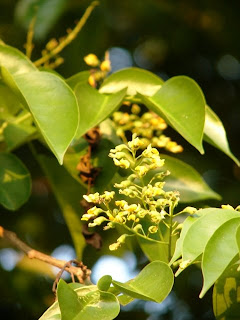
 Prof. Mary Ann Espina was pointing out in class that it is important for landscape students to know and see the flowering season of trees. The presence of flowers in landscape plant species is definitely a plus factor for softscape selection especially when candidates have spectacular blooms with colorful displays and unique scents. She encourages the students to literally go out and smell them flowers. She specifically mentioned the narra, but its magnificent yellow sprays last only a couple of days and most probably they have fallen by now.
Prof. Mary Ann Espina was pointing out in class that it is important for landscape students to know and see the flowering season of trees. The presence of flowers in landscape plant species is definitely a plus factor for softscape selection especially when candidates have spectacular blooms with colorful displays and unique scents. She encourages the students to literally go out and smell them flowers. She specifically mentioned the narra, but its magnificent yellow sprays last only a couple of days and most probably they have fallen by now.February and March are actually good times to find these species as most of them are in flower after the long cold season. In the Universtiy of the Philippines, Diliman Campus alone, there are quite a number of interesting species with worth while inflorescence to see. Hope some of you could catch them.

 An impressive exhibiton of upright flowers can be seen in most siar or Peltophorum pterocarpum specimens. They have the most showy among yellow flower bearers (probably second only to the golden showere or Cassia fistula, which is not native) . Siar is disputed as native with a few botanists claiming large trees could be seen in old Philippine forests.
An impressive exhibiton of upright flowers can be seen in most siar or Peltophorum pterocarpum specimens. They have the most showy among yellow flower bearers (probably second only to the golden showere or Cassia fistula, which is not native) . Siar is disputed as native with a few botanists claiming large trees could be seen in old Philippine forests.
 A rare tree to see is supa or Sindora supa. That is why to see it in flower in the metro is actually worth the sighting. The flower would eventually yield a number of seed bearing pods. I only know a lone supa specimen in the Diliman campus, it is located at the back of the Bahay ng Alumni, beside another beautiful tree-amugis.
A rare tree to see is supa or Sindora supa. That is why to see it in flower in the metro is actually worth the sighting. The flower would eventually yield a number of seed bearing pods. I only know a lone supa specimen in the Diliman campus, it is located at the back of the Bahay ng Alumni, beside another beautiful tree-amugis.
 A revelation is a small tree at that end of the pathway coming from Vargas museum to the lagoon. The tree stands married to another native, kalios or Streblus asper. It is salingbobog or Crataeva religiosa, which could be found growing on limestone cliffs of Palawan. Yellow and peach orchid-like flowers cover the entire extent of its branches.
A revelation is a small tree at that end of the pathway coming from Vargas museum to the lagoon. The tree stands married to another native, kalios or Streblus asper. It is salingbobog or Crataeva religiosa, which could be found growing on limestone cliffs of Palawan. Yellow and peach orchid-like flowers cover the entire extent of its branches.
 The biggest display is the white flowers of katmon or Dillenia philippinensis. They are short lived lasting only till noontime. But the specimen in front of Melchor Hall has a lot of buds that would probably open up in the following weeks.
The biggest display is the white flowers of katmon or Dillenia philippinensis. They are short lived lasting only till noontime. But the specimen in front of Melchor Hall has a lot of buds that would probably open up in the following weeks.
No comments:
Post a Comment